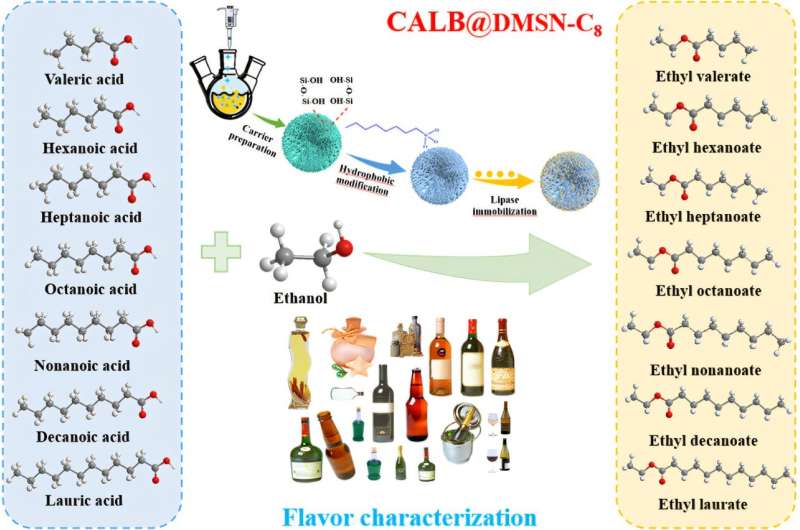Science
Researchers Unveil Advanced Enzyme Technology to Enhance Flavor Production

A team of researchers has developed an innovative and reusable biocatalyst that could revolutionize flavor production in the food and cosmetics industries. Co-led by scientists from Newcastle University, the research introduces a novel method for attaching enzymes to specially engineered, sponge-like silica particles. This approach enables the production of flavor esters, which are essential for creating appealing scents and tastes in various products, in a highly efficient and solvent-free manner.
The findings, published on July 24, 2025, in the Journal of Agricultural and Food Chemistry, address significant challenges in biocatalysis. The new enzyme system demonstrates exceptional catalytic efficiency, thermal stability, and reusability, earning it a feature on the journal’s cover due to its scientific significance.
Study co-author Dr. Vladimir Zivkovic, a Senior Lecturer at the School of Engineering, emphasized the research’s potential, stating, “This research marks a significant leap forward in the field of enzyme technology and green chemistry. The ability to achieve such high conversion rates with excellent reusability opens new pathways for industrial applications—from flavor and fragrance synthesis to broader bioprocessing uses.”
Dr. Zivkovic expressed pride in seeing the work highlighted on the journal cover and acknowledged the role of a Newcastle alumnus in leading this impactful innovation.
Another co-author, Dr. Kheng-Lim Goh, an Associate Professor and Reader in Mechanics of Composite Materials at Newcastle University in Singapore, highlighted the interdisciplinary nature of the project. He stated, “The work showcases how an interdisciplinary approach—combining materials science, biochemical engineering, and computational modeling—can overcome long-standing challenges in enzyme design. That it has been featured on the cover of a leading journal is a testament to its importance, and to have it led by a Newcastle graduate is something we are especially proud of.”
This breakthrough underscores the global impact of research conducted at Newcastle University. Lead author Dr. Yi Zhang, who completed both his MSc and Ph.D. at Newcastle, embodies a new generation of scientists dedicated to driving real-world innovation.
The study, titled “Novel Immobilized Enzyme System Using Hydrophobic Dendritic Mesoporous Silica Nanospheres for Efficient Flavor Ester Production,” was co-authored by Run Liu and others, further contributing to the field’s advancement. The research not only has implications for food and beverage industries but also paves the way for broader applications in bioprocessing.
The promising results of this study highlight the importance of continued investment in enzyme research, particularly in enhancing production efficiency while adhering to sustainable practices. As the demand for natural flavors and fragrances continues to rise, innovations such as these could play a crucial role in meeting industry needs while minimizing environmental impact.
-

 Entertainment3 months ago
Entertainment3 months agoAnn Ming Reflects on ITV’s ‘I Fought the Law’ Drama
-

 Entertainment4 months ago
Entertainment4 months agoKate Garraway Sells £2 Million Home Amid Financial Struggles
-

 Health3 months ago
Health3 months agoKatie Price Faces New Health Concerns After Cancer Symptoms Resurface
-

 Entertainment3 months ago
Entertainment3 months agoCoronation Street’s Carl Webster Faces Trouble with New Affairs
-

 Entertainment3 months ago
Entertainment3 months agoWhere is Tinder Swindler Simon Leviev? Latest Updates Revealed
-

 Entertainment4 months ago
Entertainment4 months agoMarkiplier Addresses AI Controversy During Livestream Response
-

 Science1 month ago
Science1 month agoBrian Cox Addresses Claims of Alien Probe in 3I/ATLAS Discovery
-

 World2 weeks ago
World2 weeks agoBailey Announces Heartbreaking Split from Rebecca After Reunion
-

 Health4 months ago
Health4 months agoCarol Vorderman Reflects on Health Scare and Family Support
-

 Entertainment4 months ago
Entertainment4 months agoKim Cattrall Posts Cryptic Message After HBO’s Sequel Cancellation
-

 Entertainment3 months ago
Entertainment3 months agoOlivia Attwood Opens Up About Fallout with Former Best Friend
-

 Entertainment2 weeks ago
Entertainment2 weeks agoCoronation Street Fans React as Todd Faces Heartbreaking Choice











